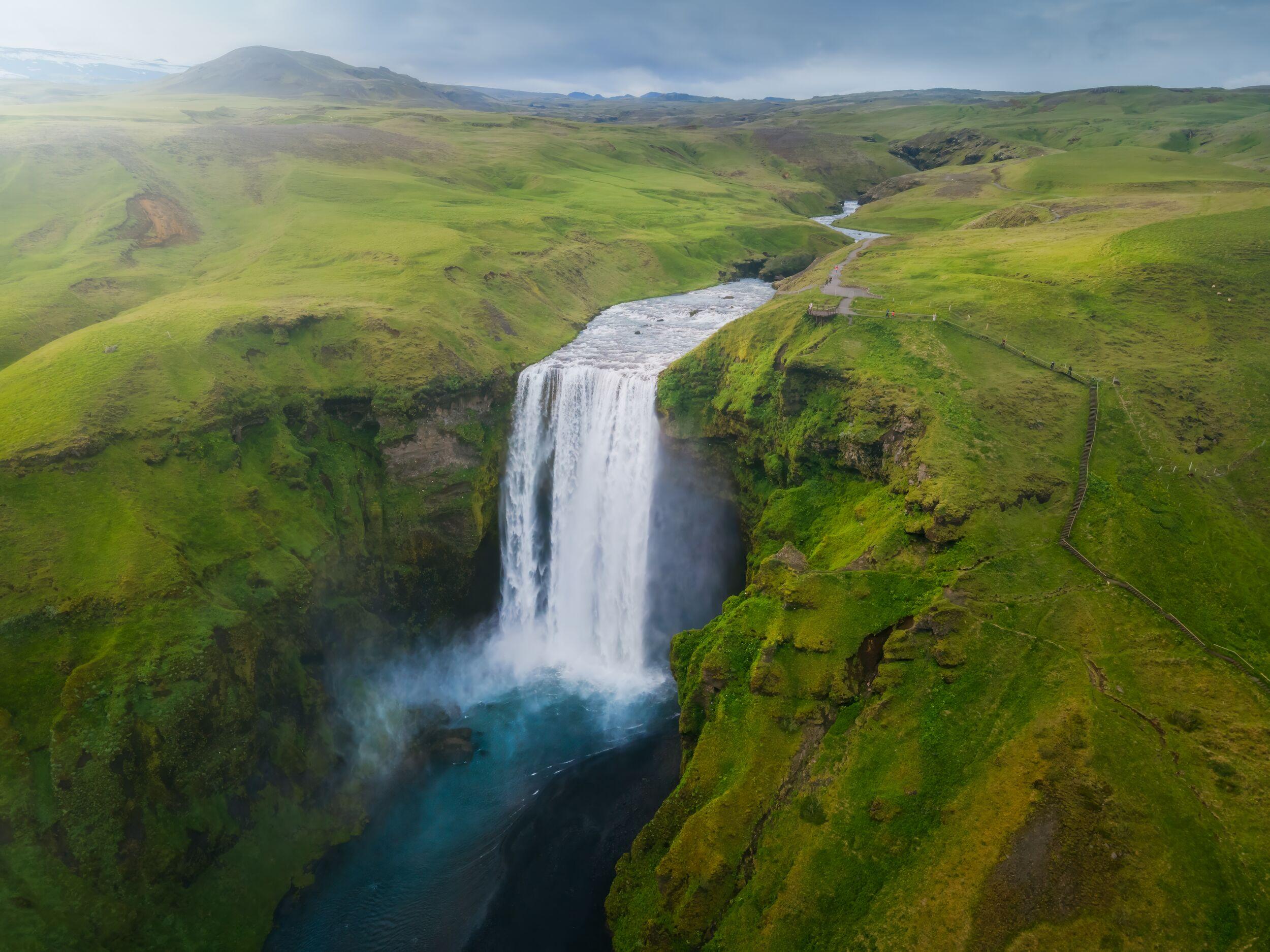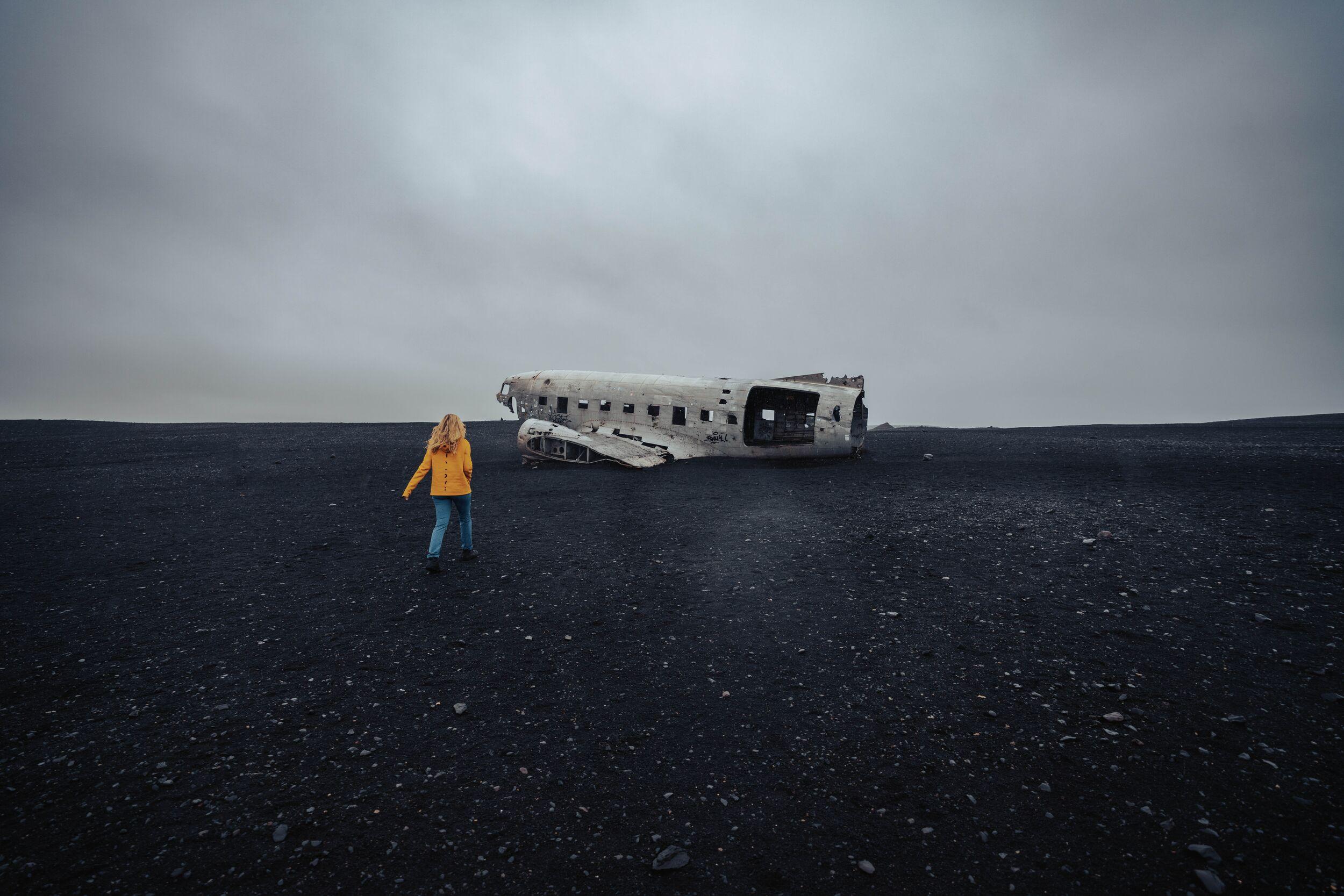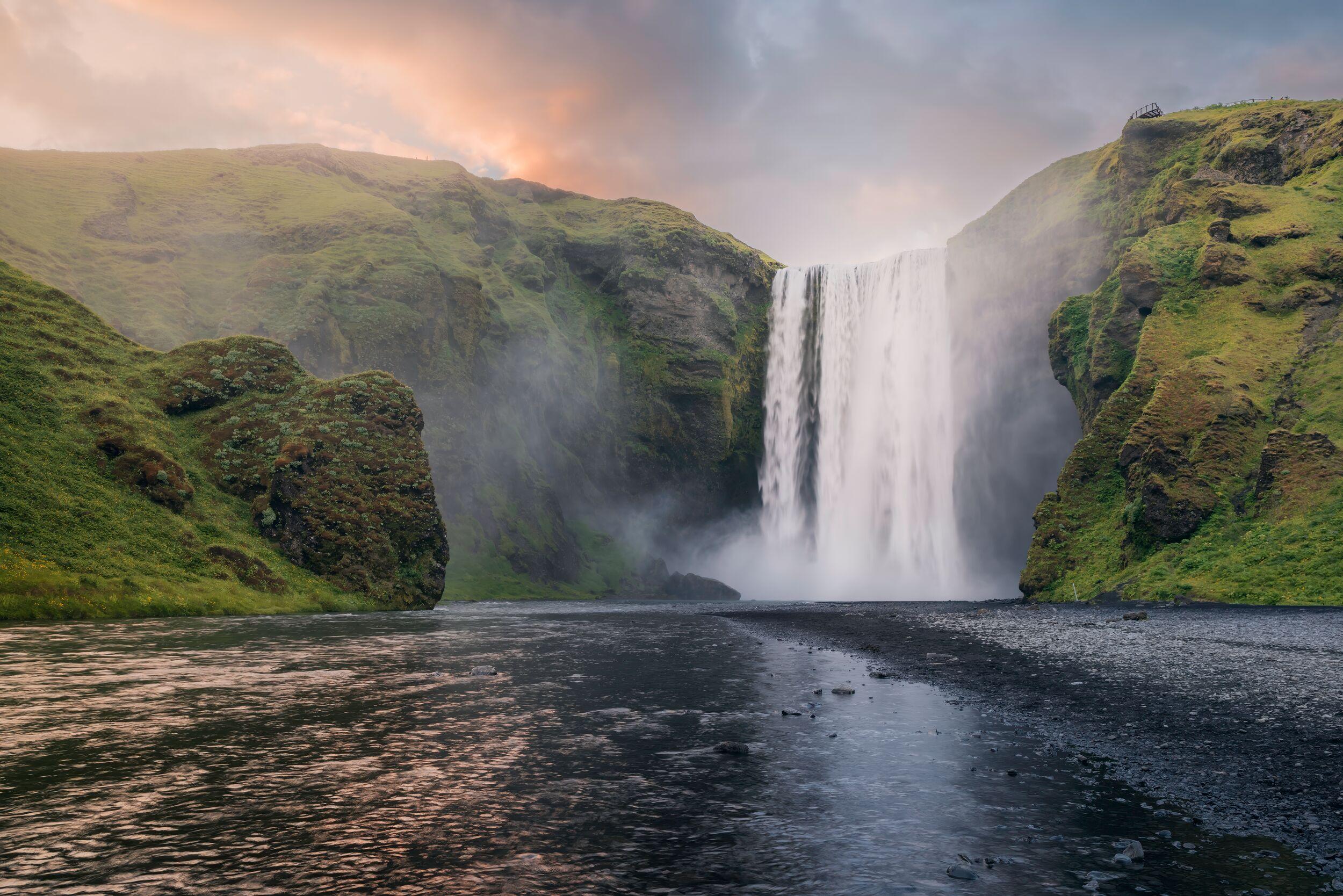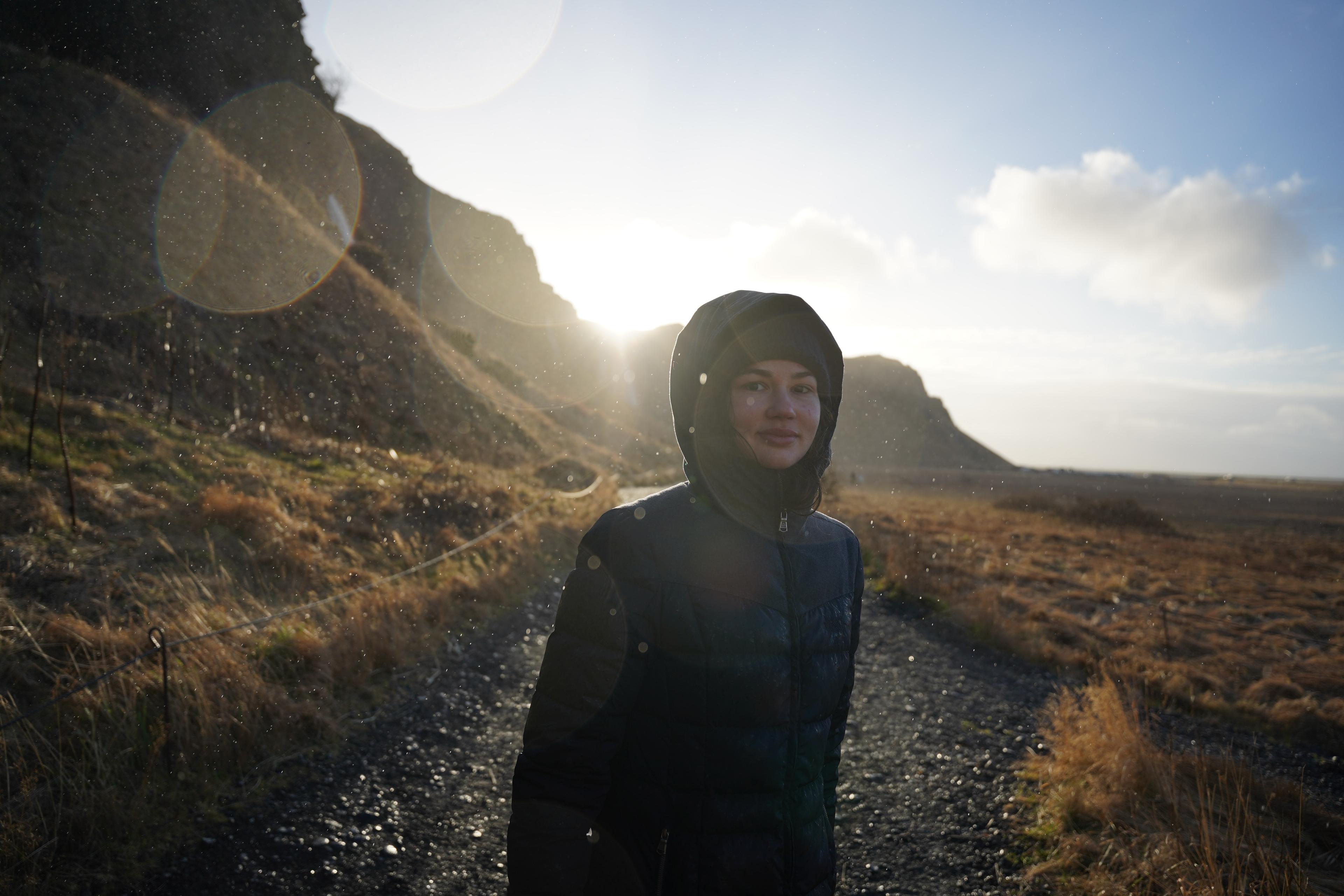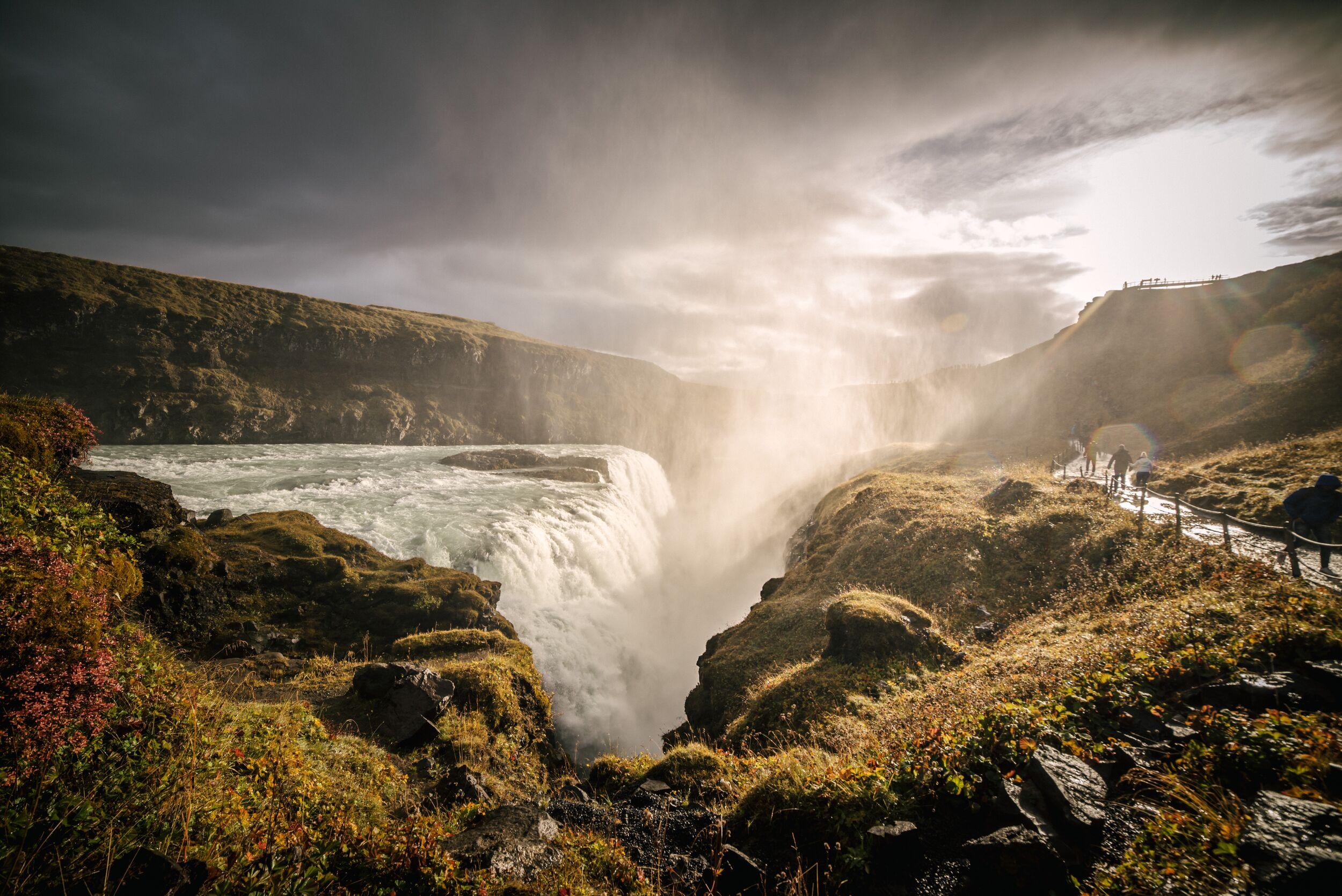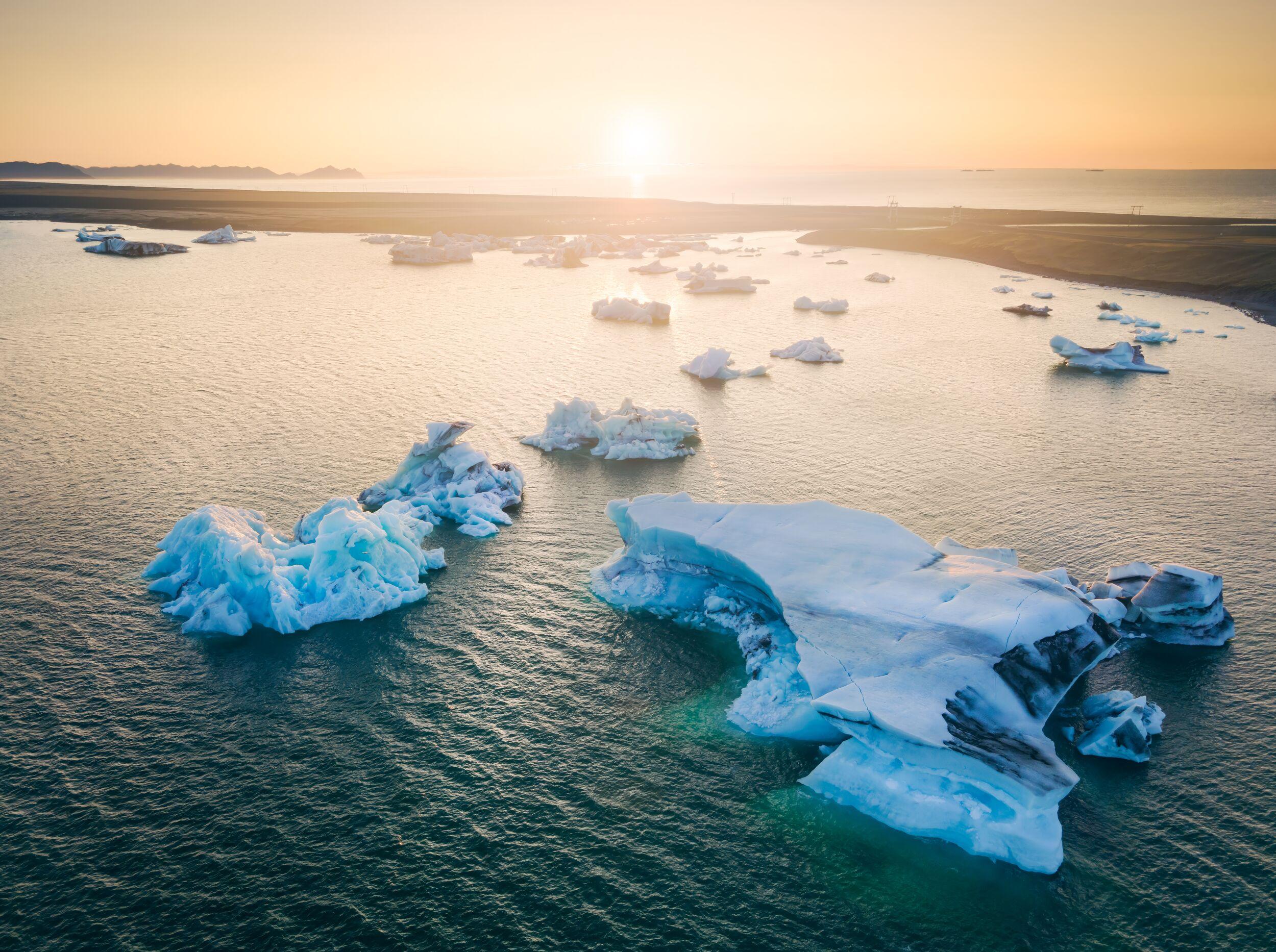Your Ultimate Guide to the South Coast of Iceland
Table of Contents
In a world where natural beauty often lies hidden in remote corners, Iceland's South Coast stands as a remarkable exception. Here, a mere day's journey from the nation's capital unfolds an array of natural wonders so magnificent, each could justify the journey across oceans on their own merit. It’s a rare and delightful occurrence where treasures of such grandeur are not only in abundance but also effortlessly accessible along the main road, and waiting to be explored with close to zero effort.
In this guide, we'll take you on a journey through some of the most breathtaking sights in this extraordinary region and share tailored advice suited to various travel preferences. Continue reading to discover the wonders along one of Iceland's most iconic travel routes.
What’s the best way to travel the South Coast of Iceland?
Exploring the South Coast is straightforward from Reykjavík, thanks to the well-travelled Ring Road. Imagine setting off on a day trip from the capital and finding yourself back in Reykjavík within 10 to 12 hours, having traversed to Vik and back, with your memories enriched by visits to stunning beaches and majestic waterfalls.
For those seeking a deeper dive into the South Coast’s wonders, a 14 to 15-hour expedition, encompassing the ethereal Diamond Beach and the mesmerising Jokulsarlon Glacier Lagoon, becomes an unforgettable adventure, especially during the extended daylight of summer.
Public transport in this region is limited, primarily serving locals travelling between towns thus not making stops at the natural attractions. There is, however, a plethora of guided South Iceland tours available, tailored to the needs of travellers and peppered with delightful stops along the way.
Not only are these tours often even cheaper than public buses, but their efficiency in covering sights is unmatched. These guided experiences bring you face-to-face with the area's most celebrated locations, enriched by the narratives of an English-speaking guide, with many tours also offering audio guides in various languages.
For those who prefer the liberty of steering their own course, self-driving in South Iceland remains a favoured choice. This option opens up a world of adventurous activities, from glacier hikes and ice caving to snowmobiling or ATV tours and more.
Along your self-guided route, local visitor centers and accommodation providers stand ready to offer pearls of wisdom, ensuring your journey through South Iceland is as enriching as it is exhilarating.
Must-See Attractions on the South Coast of Iceland
As you journey along, the road winds beside rugged mountains, through landscapes blanketed in ethereal lava fields, past quaint villages, and across pastoral farmlands. Volcanic giants like Katla, Hekla, and the infamous Eyjafjallajökull are visible, offering awe-inspiring backdrops to your road trip.
The South Coast is a treasure trove of sights, each with its own unique charm and story. Here are some of the top attractions you'll encounter on your journey, conveniently listed in order of their distance from Reykjavik, making it easy to plan your unforgettable Icelandic adventure.
Hveragerði Geothermal Park and Iceland's Longest Zipline
For self-drive explorers venturing along Iceland's South Coast, a stop at Hveragerði is a delightful detour. Just over 40 km from Reykjavík, this quaint town is a hotspot of geothermal activity. Here, you can experience the unique Mega Zipline, a heart-pumping journey above stunning landscapes, offering views and thrills unmatched elsewhere.
Following the rush of the zipline, explore an active geothermal site, where you can cook an egg in the hot spring, and witness locals baking traditional Icelandic black bread underground. Perfect blend of a relaxing break and an adrenaline boost, making it an essential addition to your self-drive itinerary in summertime.
The Epic Mega Zipline in Hveragerdi
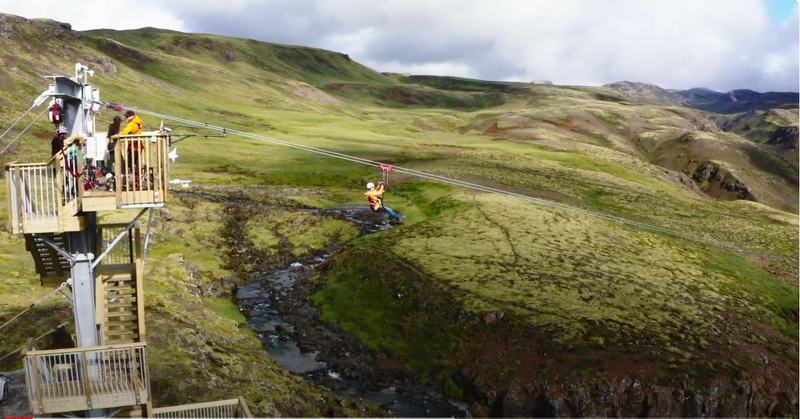
Seljalandsfoss Waterfall: A Jewel of Iceland's South Coast
A visit to Seljalandsfoss is an unmissable highlight on Iceland's South Coast. This majestic waterfall, nourished by the meltwater from Eyjafjallajökull, stands as a true adventure in itself. For many visitors to Iceland, Seljalandsfoss sits at the very top of their bucket lists as it captures the very spirit of Iceland thanks to the immersive experience it offers.
The path leading behind the cascade grants visitors a chance to literally step inside the panorama. It offers a thrilling and unparalleled perspective, transforming the experience into something truly special and memorable.
Seljalandsfoss is hard to miss, as its impressive form is visible from the road from hundreds of meters away. Above the falls, the towering Eyjafjallajökull glacier stands as a monumental backdrop, feeding the waterfall and adding to the grandeur of the scene.
In the wintertime, Seljalandsfoss offers a distinctly different experience. As temperatures drop, parts of the waterfall freeze, creating an enchanting display of giant icicles and a thick sheet of ice around the cascade. This icy transformation, while breathtaking, means that the path behind the waterfall is often closed during the winter months for safety reasons.
However, the frozen landscape provides a new, mesmerizing perspective, showcasing the waterfall's beauty in a whole different light. Whether visited in the lushness of summer or the icy grip of winter, Seljalandsfoss remains a jewel in the crown of Iceland's natural wonders.
Gljúfrabúi: The Hidden Waterfall Gem
Just a short and scenic walk from Seljalandsfoss, you'll find the hidden gem of Gljúfrabúi, a lesser-known but equally mesmerizing waterfall. Accessing Gljúfrabúi is an adventure in itself, adding a dash of excitement to your exploration.
From Seljalandsfoss, a clearly marked path leads you on a beautiful walk through a verdant landscape dotted with multiple tiny waterfalls, each adding to the charm of the journey. This pleasant walk takes about five minutes, so it's advisable to allocate at least an additional 20 minutes to your visit at Seljalandsfoss to fully enjoy Gljúfrabúi.
Reaching Gljúfrabúi rewards you with the sight of its captivating cascade, a serene experience distinct from its more famous neighbour. The waterfall's somewhat hidden location nestled within a cleft in the rocks makes the encounter feel personal and exclusive.
Do expect to get a bit wet during this part of the adventure and be prepared to wade through shallow waters and carefully navigate over rocks to reach this secluded spot. This is all part of the immersive experience in Iceland's stunning landscapes!
Eyjafjallajökull: Iceland's Infamous Glacier-Capped Volcano
Continuing east along the South Coast, you'll soon find yourself in the imposing presence of Eyjafjallajökull, a dominating and awe-inspiring feature of the Icelandic landscape. This glacier-capped volcano, soaring over 1,650 meters (5,400 feet), etched its name in global history in 2010. Its massive eruption that year catapulted Iceland onto the global travel map.
The eruption generated a colossal ash cloud, causing significant disruption to air travel, grounding flights worldwide, and stranding numerous travelers. Although there were no direct casualties, the event impacted millions and even influenced the climate in Europe. This eruption, while disruptive, sparked a newfound global interest in Iceland’s pristine and unspoiled landscapes, leading to a surge in tourism to our little home.
While there isn't a specific stop for Eyjafjallajökull, as the glacier itself is not readily accessible, the volcano's dramatic presence in the landscape is unmistakable. As you journey along the South Coast, the sight of Eyjafjallajökull's towering form, blanketed in ice, offers a spectacular and memorable view, adding a unique dimension to your Icelandic adventure.
Skógafoss Waterfall and the Skógar Museum: A Blend of Natural and Cultural Wonders
Skógafoss Waterfall, in a country celebrated for its natural wonders, stands out as one of Iceland's most magnificent waterfalls. With a width of 24 meters (78 feet) and a drop from cliffs equivalent to a 20-story building, the waterfall is truly a breathtaking sight. Feel the mist on your face and listen to the thunderous roar of the water as you stand at the base, then take the opportunity to climb the stairs to the top for a different perspective. This iconic waterfall may feel familiar, as it has graced the screen in several movies and TV shows, including 'Game of Thrones' and 'Vikings'.
Legend has it that behind the cascade, lies a chest filled with riches, supposedly concealed there by Þrasi Þórólfsson, a Viking settler and the area's first inhabitant. According to the tale, Þrasi buried the chest in a cave behind the waterfall. Over the centuries, many have been lured by the promise of this hidden treasure, hoping to uncover the chest and claim its contents. It's said that a local boy once managed to find the chest and attempted to retrieve it. However, he was only able to grasp the golden ring on the side of the chest before it disappeared again.
While the treasure remains undiscovered, the ring is on display at the Skógar Museum, not far from the waterfall itself. Skógar is an essential stop for those interested in Icelandic cultural heritage. This skanzen, or open-air museum, houses a remarkable collection of over 18,000 regional folk craft artifacts. The museum comprises three buildings and six historical structures, each offering a window into the rich cultural and historical tapestry of the region. Visiting the Skógar Museum provides a perfect complement to the natural spectacle of Skógafoss, offering a comprehensive experience of both the natural beauty and cultural heritage of Iceland's South Coast.
Sólheimajökull and Mýrdalsjökull: Thrilling Adventures on Iceland’s Glaciers
As you continue your journey along the South Coast, a striking natural phenomenon comes into view: an outlet glacier extending from the vast ice cap of Mýrdalsjökull. This impressive glacial formation, a tangible extension of Iceland's 4th largest glacier, presents a captivating sight and a testament to the dynamic nature of Iceland's landscape.
This outlet glacier is known as Sólheimajökull, a destination that attracts adventurers with its array of thrilling activities: glacier hiking, ice climbing, and even kayaking in its glacier lagoon. This glacier is a focal point for those seeking to immerse themselves in the awe-inspiring icy landscapes of Iceland.
Sólheimajökull is renowned for its easily accessible terrain, allowing a wide range of visitors to safely engage in the glacier's experiences and marvel at the stunning icy landscape up close.
In addition, snowmobile tours are offered further atop Mýrdalsjökull allow visitors to traverse the vast ice cap, surrounded by breathtaking panoramic views. The adventure base camp at Sólheimajökull and Myrdalsjökull are perfect stops on the South Coast for adventure lovers seeking to immerse themselves in Iceland's spectacular glacial landscapes.
DC-3 Plane Wreck on Sólheimasandur Beach: A Journey to the Past
Continuing your drive eastward, you'll soon come across a strange sight: a parking lot brimming with cars, seemingly situated in the middle of nowhere. This curious scene unfolds on an expansive, flat landscape, where visitors are seen embarking on foot, heading straight into the vast open desert.
This intriguing setting is the starting point for those venturing to the famous Sólheimasandur plane wreck, a journey that marries the mystery of an abandoned relic with the stark beauty of Iceland's untamed nature.
This abandoned wreckage, resting on the black sands of a desolate beach, presents an eerie yet captivating scene. Its isolated location has not deterred visitors, many of whom are drawn by the enigmatic allure captured in numerous social media posts.
The DC-3 aircraft, once operated by the US Navy, met its fate in November 1973 when it crash-landed on this very spot. In a miraculous turn of events, all seven crew members on board survived, despite believing they were moments from death. The exact cause of the crash remains shrouded in mystery. Some reports attribute it to mechanical failure, while others speculate that a fuel mishap led to the plane running out of gas.
No efforts were made to salvage the plane, and over time, it has become a part of the landscape, destined to remain until nature eventually reclaims it. Today, this site has taken on a new life as an adventurous destination. ATV and Buggy tours operate in the area, providing a thrilling experience for visitors who wish to explore this unique piece of history amidst the rugged beauty of Iceland’s coastal landscape.
Reynisfjara Black Sand Beach: Proudly Top Listed by National Geographic
Reynisfjara Black Sand Beach has earned a spot among the most-visited sites in Iceland. Its breathtaking beauty is so profound that National Geographic has lauded it as one of the most beautiful beaches in the world.
Visitors to Reynisfjara are captivated by its stark black sands, towering sea stacks, thrilling hexagonal pillars, and rugged cliffs. The beach is adorned with fascinating rock formations and hidden caverns, creating a landscape that feels almost otherworldly. During the summer months, from May to August, the cliffs become a haven for puffins, adding a touch of wildlife charm to the scene.
A standout feature of Reynisfjara is the Reynisdrangar, a group of 15-meter-tall basalt rock stacks that emerge dramatically from the ocean. Local lore adds a mystical element, suggesting these formations are the petrified remains of trolls caught in the sunlight while attempting to pull a boat from the water.
Another otherworldly feature of the beach is the striking hexagonal basalt columns. These naturally occurring formations add a unique geometric pattern to the landscape. Formed by the cooling of lava over centuries, these columns create a captivating backdrop, perfect for photography enthusiasts and nature lovers alike. Their presence enhances the mystical and almost mythical aura of Reynisfjara, making it a place where nature's creativity is on full display.
However, the beauty of Reynisfjara comes with a need for caution. Visitors should always be vigilant and heed warning signs, staying a safe distance from the shoreline. The beach is notorious for its unpredictable and powerful Sleeper, Sneaker, or Rogue Waves. These waves can suddenly surge onto the shore with enough force to knock a person over and drag them into the icy, treacherous waters. The combination of strong currents and cold temperatures can be perilous, making safety a top priority while enjoying the mesmerizing landscape of Reynisfjara Black Sand Beach.
Vík Village and Víkurfjara Beach: A Scenic Coastal Retreat
Vík í Mýrdal, often simply referred to as Vík, is a picturesque small town located only 15 minutes drive from Reynisfjara and a key stop on any South Iceland tour. It's a vital hub offering a variety of accommodations, dining options, shopping, and other tourist services. The town's charm is amplified by its friendly atmosphere and the stunning natural beauty that surrounds it.
A must-visit in Vík is the town's iconic church, perched on a hill. This small yet beautiful church is not just a place of worship but a vantage point offering panoramic views of the town against the backdrop of the Atlantic Ocean.
The sight from here is breathtaking, encompassing the sprawling black sands of the beaches below and the distant Reynisdrangar sea stacks. The church, with its simple and elegant design, stands out as a peaceful haven, inviting visitors to take a moment to absorb the serene beauty of the area.
Down from the church, Víkurfjara Beach awaits, known for its striking black sand and impressive views of the Reynisdrangar. The beach is a perfect spot for a leisurely stroll, or even a horseback riding tour, where the rhythm of the waves and the unique landscape create a tranquil and invigorating atmosphere.
Fjaðrárgljúfur Canyon: A Surreal Landscape in Southeast Iceland
Fjaðrárgljúfur Canyon, while an incredibly special and mesmerizing location, is a bit of a detour from the main Ring Road and is typically not included in day tours due to time constraints. However, for those who have the opportunity, this detour is well worth the extra effort. The unique and surreal beauty of the canyon makes it a must-visit for those seeking to explore the less-traveled paths and experience some of Iceland’s most extraordinary natural wonders.
Nestled near the village of Kirkjubæjarklaustur, and 261 km (162 miles) from Reykjavik, Fjaðrárgljúfur Canyon is a breathtaking slice of natural beauty. This impressive canyon, with its deep chasm reaching about 100 meters (328 feet) into the earth and extending over 2 kilometers (1.2 miles), offers a landscape that seems to leap from the pages of a fantasy novel. The walls of the canyon are adorned with moss and lichen, giving them a soft, green hue that contrasts strikingly with the darker tones of the volcanic rock.
Various viewpoints along the canyon's edge offer breathtaking vistas of the winding path below. The overall scenery of Fjaðrárgljúfur Canyon is akin to a living painting, with each twist and turn revealing a new, awe-inspiring perspective, making it a truly unique and enchanting sight to behold.
Eldhraun Lava Field: A Striking Testament to Nature's Power
Eldhraun Lava Field stands out as one of the most uniquely captivating sights along Iceland’s Ring Road. This vast expanse, where vibrant green moss clings to stark black lava rocks, creates a surreal landscape.
The contrast of the soft moss against the rugged, hardened lava gives an illusion of gentleness across this expansive field. Covering 565 square kilometres (218 square miles), Eldhraun is not just a significant sight in Iceland but also one of the largest lava fields in the world.
Eldhraun’s origins are rooted in one of the largest volcanic eruptions in recorded history. This cataclysmic event, known as the Skaftáreldar or The Skaftá River Fires, erupted from 1783 to 1784. Its impact was monumental, causing widespread destruction in Iceland, including disasters, disease, crop failures, and severe food shortages.
The eruption's effects reached beyond Iceland, contributing to atmospheric changes. In Britain, the resultant ash clouds led to a phenomenon known as the Sand-Summer, characterized by smog and haze. It's even speculated that the climatic changes caused by the eruption played a role in the societal unrest leading to the French Revolution.
Today, Eldhraun stands as a breathtaking and haunting reminder of nature's formidable power and the profound impact it can have on our world.
Lómagnúpur: A Majestic Landmark of Iceland’s South Coast
The grandeur of Lómagnúpur is undeniable as it stands tall at 764 meters (2,507 feet). This colossal landmark is visible from as far as 30 kilometers (18.6 miles) away in Skaftafell National Park, making it a prominent feature on the South Iceland route. Its towering presence is impossible to miss as you journey along the main road.
While many travelers continue on to more renowned destinations, taking the time to stop at Lómagnúpur is highly rewarding. The area is often peaceful, with fewer tourists, allowing for uninterrupted contemplation of the mountain's brooding beauty. The views here are dynamic, changing with the weather, offering a unique experience with each visit.
Renowned as one of Iceland’s most photographed mountains, Lómagnúpur has become an iconic symbol of the Icelandic landscape, capturing the imagination of visitors with its imposing stature and scenic backdrop.
Vatnajökull Glacier: A Frozen Wonderland
As you travel further east along the South Coast, you'll enter the majestic world of glaciers. This stunning landscape, where vast ice caps and glacial tongues stretch as far as the eye can see, will be a constant companion, dominating your view for hours as you journey through this remarkable region of Iceland.
Covering a vast 8,100 square kilometers (3,127 square miles), Vatnajökull Glacier is the world's largest ice cap outside the polar regions and is triple the size of Luxembourg. Hidden beneath this colossal ice mass is Iceland's tallest peak, Hvannadalshnúkur, soaring to 2,110 meters (6923 feet). Beneath the glacier are several active volcanoes and volcanic systems waiting to erupt.
Skaftafell Nature Reserve: A Hiker's Paradise
Formerly a national park in its own right, Skaftafell is now a part of the expansive Vatnajökull National Park. Renowned as one of Iceland’s most beloved hiking areas, it caters to all levels of hikers and trekkers, offering a variety of trails ranging from easy, leisurely walks to more challenging climbs, including the ascent to Hvannadalshnúkur, Iceland's highest peak.
Skaftafell’s well-marked and maintained trails lead adventurers through picturesque viewpoints with stunning views of glaciers, serene birch forests, and dramatic glacial valleys. It’s a veritable showcase of the country's diverse natural beauty, making it a paradise for those who love to explore the great outdoors on foot.
For the adventure seekers and glacier enthusiasts, the area is a treasure trove of thrilling activities. There are numerous opportunities for glacier hikes, ice climbing, and ice caving, all available throughout the year and led by experienced guides.
Skaftafell is just a short detour from the Ring Road and well worth a stop for at least a day to fully appreciate its beauty and offerings. However, hikers and nature enthusiasts could easily find themselves captivated for many days, exploring the myriad of trails and natural wonders this area has to offer.
Svartifoss Waterfall: A Source of Artistic Inspiration
A short and famous hike within Skaftafell National Park leads to the stunning Svartifoss Waterfall (Black Fall). This waterfall is a visual feast, with its 20-meter (80 feet) drop over a cliff framed by unique hexagon-shaped black basalt columns. Fed by meltwater from the Svínafellsjökull Glacier, Svartifoss is not just a natural wonder but also an inspiration for artists, poets, and architects.
The waterfall's distinct basalt formations have influenced various works, including the design of Reykjavik’s famous Hallgrímskirkja, which incorporates elements reminiscent of Svartifoss’s basalt columns and Thor’s hammer in its architecture. This makes Svartifoss a must-visit for those seeking both natural beauty and creative inspiration.
Jökulsárlón Glacier Lagoon: Iceland's Crown Jewel
Often hailed as the crown jewel of not only Iceland’s South Coast but perhaps all of Iceland, Jökulsárlón Glacier Lagoon is an extraordinary testament to nature's artistry. Its monumental and surreal beauty captivates all who visit, making it an unforgettable highlight of any Icelandic journey.
Jökulsárlón is a deep, mesmerizing lagoon, formed relatively recently in geological terms. Its creation is a direct result of the receding Breiðamerkurjökull glacier, an outlet of the larger Vatnajökull glacier. As the glacier retreats, it leaves behind this expansive pool of meltwater. The lagoon is continuously evolving, with the glacier shrinking further each year, making the lagoon larger and deeper over time.
To underscore the rapid effects of global warming, the Jökulsárlón Glacier Lagoon serves as a stark example. Over the past 50 years, the lagoon has quadrupled in size, a direct consequence of the accelerating retreat of the Breiðamerkurjökull glacier. This dramatic change not only illustrates the lagoon's rapid expansion but also foreshadows a significant transformation of the landscape.
In the future, it's anticipated that the lagoon will continue to expand to the point where the narrow strip of land separating it from the sea will be submerged in a few decades. This will lead to the creation of a vast bay where the lagoon currently lies.
Such a transformation would not only alter the geographic makeup of the area but also serve as a vivid, tangible indicator of the profound and lasting impacts of climate change on our planet's ecosystems and landscapes. The evolution of Jökulsárlón from a lagoon to a bay exemplifies the urgent need for awareness and action in the face of global environmental changes.
Today, the lagoon is filled with a stunning array of icebergs that have calved from the glacier, floating majestically in the icy waters. These icebergs, with their varying shapes and sizes, paint a dramatic picture against the backdrop of the glacier and the surrounding mountains. The interplay of light and the translucence of ice create a magical, ever-changing display of natural beauty.
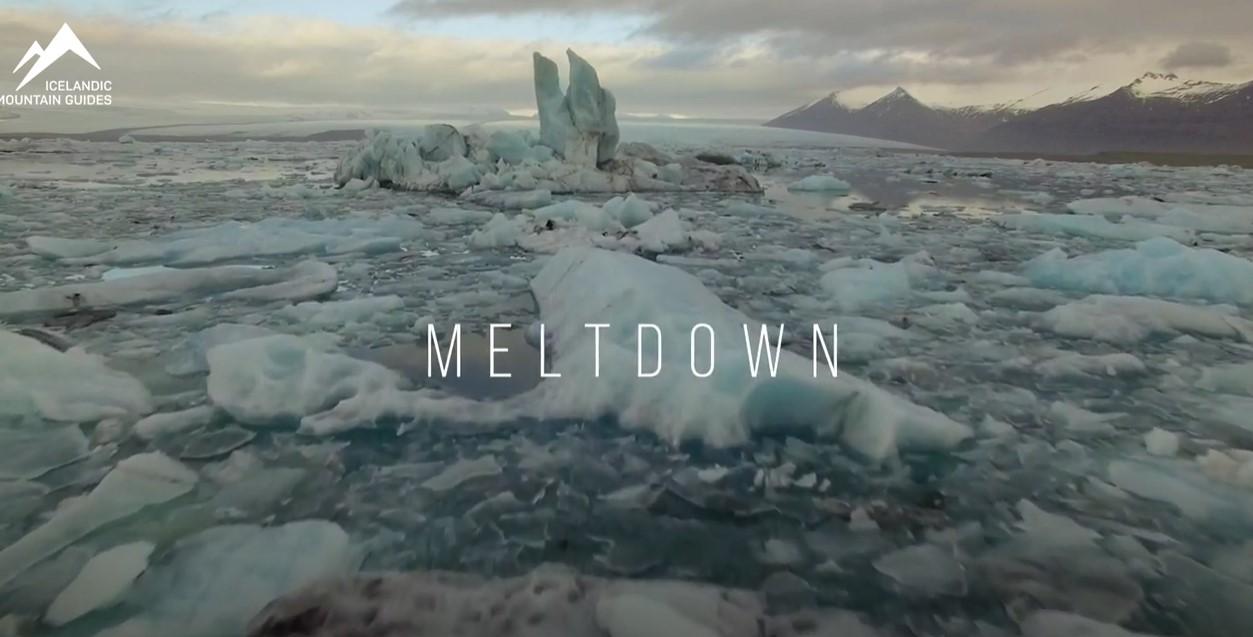
Diamond Beach: A Sparkling Creation of Nature
Diamond Beach, situated in close proximity to Jökulsárlón Glacier Lagoon, is a spectacular natural phenomenon and a must-visit location. Essentially an extension of Jökulsárlón, the beach is just a short walk away, making these two attractions seamlessly interconnected.
The creation of Diamond Beach is a direct result of the activity at Jökulsárlón. Icebergs calve from the Breiðamerkurjökull glacier, float in the lagoon, and eventually drift through the narrow channel connecting Jökulsárlón to the Atlantic Ocean. As these icebergs reach the ocean, they are often swept back onto the shore by the waves, landing on the black volcanic sands of Diamond Beach.
This process results in a breathtaking sight: chunks of crystal-clear ice scattered across the dark sands, glittering like diamonds under the sunlight. The contrast between the pristine ice and the black sand is striking, creating a surreal and picturesque landscape. The size and shape of the ice vary greatly, from small, gem-like pieces to large, imposing blocks, each adding to the unique beauty of the beach.
Visitors to Diamond Beach can witness this stunning spectacle up close, walk among the ice formations, and observe as new "diamonds" are continually washed ashore. The proximity of Diamond Beach to Jökulsárlón Glacier Lagoon makes it easy for travelers to experience two of Iceland's most extraordinary natural wonders in a single visit.
We've only scratched the surface of this remarkable region with a few highlights. The true beauty lies in the smallest details – the scent of the Icelandic wind, the gentle crackling of the glacier, the ethereal hues of transparent blue ice, the misty embrace of glacial waterfalls, and the ever-changing colors of the Arctic sun.
We invite you to come and explore Iceland's South Coast for yourself, to immerse in these subtle yet profound experiences. And when you leave, know that this place will make you want to return, inviting you to delve even deeper into its captivating secrets with every visit. Iceland's South Coast is a treasure trove waiting to be discovered, again and again.
Questions and Answers abut Iceland's South Coast
There are many Iceland south coast tours for you to choose from. Depending on the chosen length, activities, and travel style, the precise sights you’ll see will differ. That said, most south coast tours will take you to Seljalandsfoss and Skógafoss, Reynisfjara and the village of Vík, or as far as Jökulsárlón. Check out the individual tour pages to see the specific itineraries.
Whether you should do a self-drive tour of Iceland depends on your travel style and priorities. Here are some factors to consider:
1. Safety: Iceland's roads are generally well-maintained, but the terrain can vary significantly depending on the season and location. You’ll need to feel comfortable navigating mountain passes, gravel or icy roads, in darkness, and sometimes unexpected weather changes. If you're not used to driving in such conditions, this could add stress to your trip.
2. Comfort and Flexibility: One of the major advantages of a self-drive tour is the comfort and flexibility it offers. You can explore at your own pace, stop for spontaneous photo opportunities, and create your itinerary. For some, this freedom is invaluable.
3. Quality Time with Travel Companions
One of the key benefits of not opting for a self-drive tour is the ability to focus entirely on your travel companions, especially your partner or friends. When you're not behind the wheel, you can fully enjoy the journey without the distraction of navigating or managing the road. On a guided tour, you can relax, take in the stunning Icelandic landscapes, and engage in meaningful conversations without worrying about directions, fuel stops, or traffic conditions.
4. The Stress of Driving: Driving can be stressful, especially in a foreign country with unfamiliar road signs, changing weather conditions, and remote areas where services may be scarce. Navigating long distances, managing fuel stops, and ensuring you're on the right route can feel overwhelming for some, especially if you're the sole driver. In the winter, it’s crucial to check road conditions frequently and ensure your car is equipped for icy roads.
The south coast of Iceland is packed with incredible sights, from volcanic peaks to black-sand beaches. A tour through all of the major sights is one of the most memorable things you can do in the country.
Here’s a taste of what you can see:
- Seljalandsfoss and Skógafoss. Two of Iceland’s most impressive waterfalls are a short distance away from each other on the south coast. You can even walk behind the elegant stream of Seljalandsfoss.
- Reynisfjara beach. When people speak of black-sand beaches in Iceland, they mean Reynisfjara. It’s mysterious, wild, and completely unforgettable.
- Skaftafell. A nature reserve that makes up part of the Vatnajökull National Park, here you’ll find some of Iceland’s best scenery.
- Jökulsárlón glacier lagoon. Rightly one of Iceland’s most famous sights, it’s an evocative lake full of floating icebergs.
There’s plenty more to see too!
That’s up to you! Guided tours give you the opportunity to get an insider’s perspective on Iceland, while seeing the top sights and meeting like-minded travellers at the same time.
But they’re not for everyone. If you prefer greater freedom, take a self-drive tour and enjoy the south coast of Iceland at your own pace.
North Iceland and the south coast have their own particular character. The south coast has most of the country’s most famous sights and it benefits from being really accessible from the capital, Reykjavík. Meanwhile, the north tends to be quieter, although it’s just as scenic.
You don’t need to choose between them, though. Join a tour that takes you around the whole of Iceland along the iconic Route 1 ring road.
How long you should spend on the south coast of Iceland depends on how long you have in the country. While some people fit the whole region into a single day, others take two or three days or even longer.
Ultimately, the choice is yours! But no matter how long you have, you’ll find something to take your breath away.
There are many Iceland south coast itineraries for you to choose from. Depending on the chosen length, activities, and travel style, the precise sights you’ll see will differ.
That said, most south coast tours will take you to Seljalandsfoss and Skógafoss, Reynisfjara and the village of Vík, and as far as Jökulsárlón. Check out the individual tour pages to see the specific itineraries.
In Iceland there’s a tour for you no matter who you are and what you like doing. Tours are a great way to visit the most incredible sights across the country, from the Golden Circle to Jökulsárlón and everything in between.
On a tour of Iceland you can also try out experiences you would never have previously considered. Go snorkelling or snowmobiling, visit an ice cave or a lava tunnel, or see the northern lights.
Many visitors to Iceland visit the south coast in a single day. On a south coast and glacier lagoon tour from Reykjavík, you can fit in all of the best sights and return to your hotel in the city.
Expect an action-packed day! But if you’d prefer to take it a little more slowly, you can spread your south coast tour over two or three days.
The south coast of Iceland stretches from just outside of Reykjavík to as far as the Vatnajökull Nation Park. While some of the closest south coast sights are less than two hours from the city, Jökulsárlón is about five hours’ drive.
Late spring and the summer months are the best time to drive around Iceland yourself. This is when the weather tends to be warmer, drier, and less volatile. You’re also much less likely to find snow and ice, and most of the highland roads will be open for exploration (as they’re closed during the winter).
There’s the added benefit of longer hours of light in the summer too. It gives you extra time to explore before it gets dark.
The south coast of Iceland is packed with incredible sights, from volcanic peaks to black-sand beaches. A tour through all of the major sights is one of the most memorable things you can do in the country.
Here’s a taste of what you can see:
Seljalandsfoss and Skógafoss. Two of Iceland’s most impressive waterfalls are a short distance away from each other on the south coast. You can even walk behind the elegant stream of Seljalandsfoss.
Reynisfjara beach. When people speak of black-sand beaches in Iceland, they mean Reynisfjara. It’s mysterious, wild, and completely unforgettable.
Vík is a picturesque coastal village across the mountain from Reynisfjara. Renowned for its dramatic black-sand beaches, iconic Reynisdrangar sea stacks, and its pivotal position along the country's scenic Ring Road. As the southernmost village in Iceland, Vík serves as an essential stop for travellers, offering both natural beauty and vital amenities.
Skaftafell Nature Reserve. A nature reserve that makes up part of the Vatnajökull National Park, you’ll find some of Iceland’s best scenery here. Get the most out of your visit to Skaftafell by joining a glacier hike tour!
Jökulsárlón glacier lagoon. Rightly one of Iceland’s most famous sights, it’s an evocative lake full of floating icebergs.
There’s plenty more to see, too!
You can travel along the south coast of Iceland without a guide. But you’ll need to hire a car and drive yourself. In winter conditions this can be a challenge for less able and confident drivers. You’ll also miss out on many of the insights that a local guide will share.
That said, travelling the south coast by yourself can be a thrilling trip.
You can choose between south coast and glacier lagoon tours of many different lengths.
For example, some people decide to take a south coast tour from Reykjavík that shows them the region's highlights in a single day. Others prefer to add an overnight stop or two to see the sights more leisurely.
If you have the time to spare, you could even book a longer south coast tour. You’ll get a much deeper feel for the area and see some of the sights that most visitors tend to miss.
Related Articles
See all articlesRecommended tours
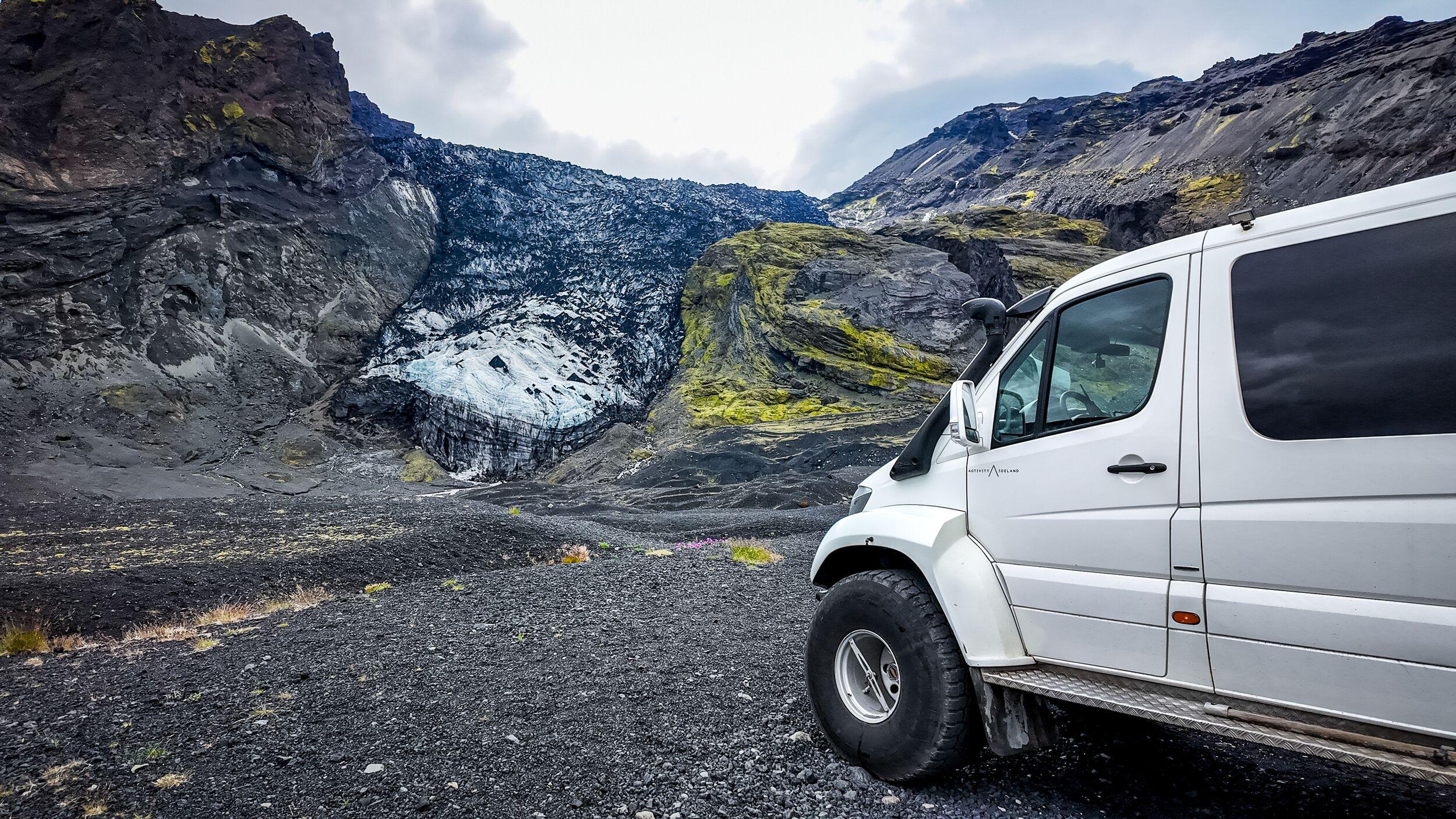
South Coast Explorer - Waterfalls, Black Beaches & Glacier Views
Buckle up for an epic South Coast adventure where waterfalls thunder, glacier rivers splash beneath your tires, and black sand beaches stretch to the horizon. This isn’t your average sightseeing tour—it’s a rugged, small-group experience that takes you deeper into Iceland’s dramatic landscapes, all from the comfort of a luxury Super Jeep.
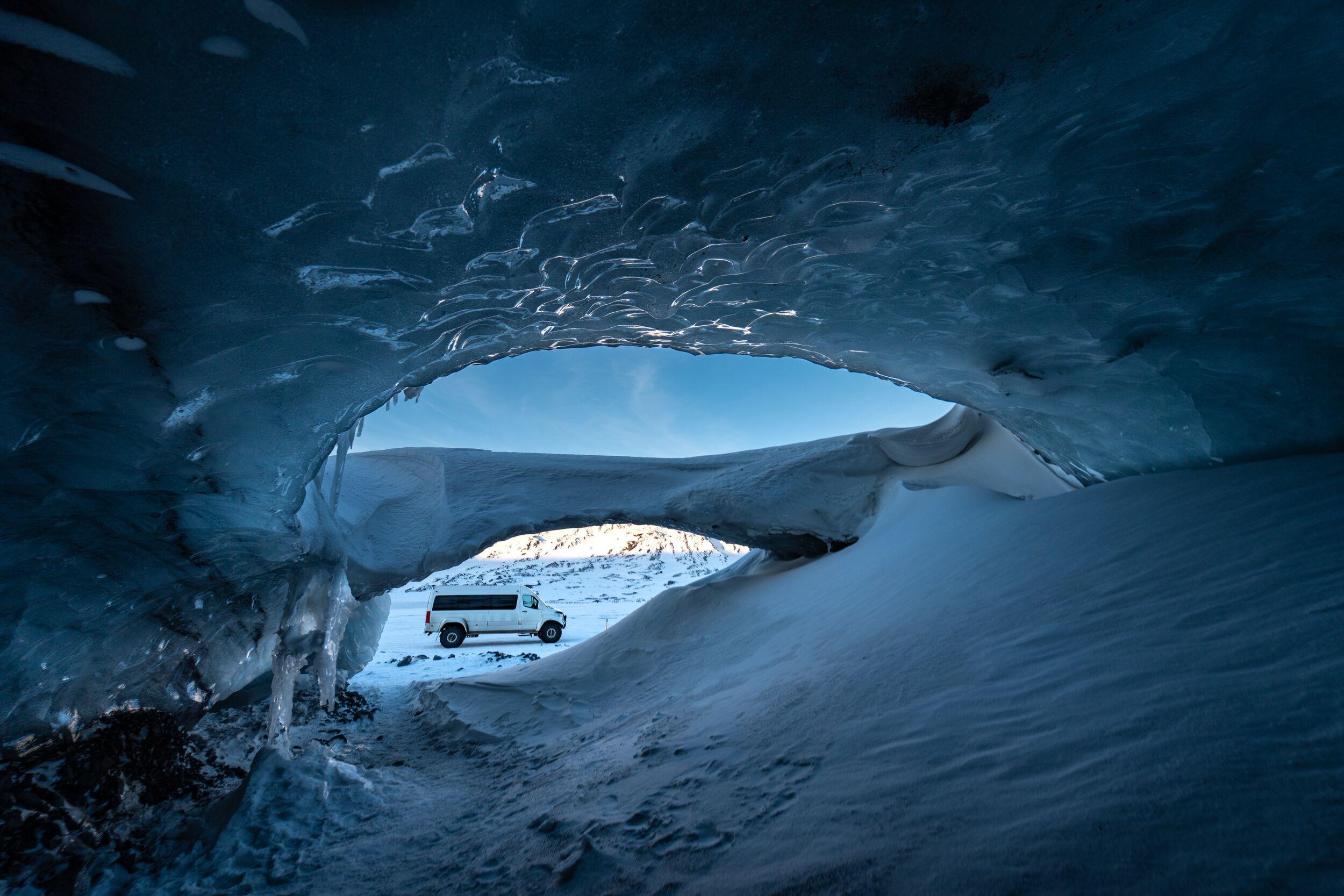
South Coast & Ice Cave offbeat adventure
Join our South Coast Iceland Super Jeep Tour to explore stunning waterfalls, black sand beaches, and a magical glacier ice cave. Travel in comfort and style in our luxury Super Jeep with a small group for a more personal experience.
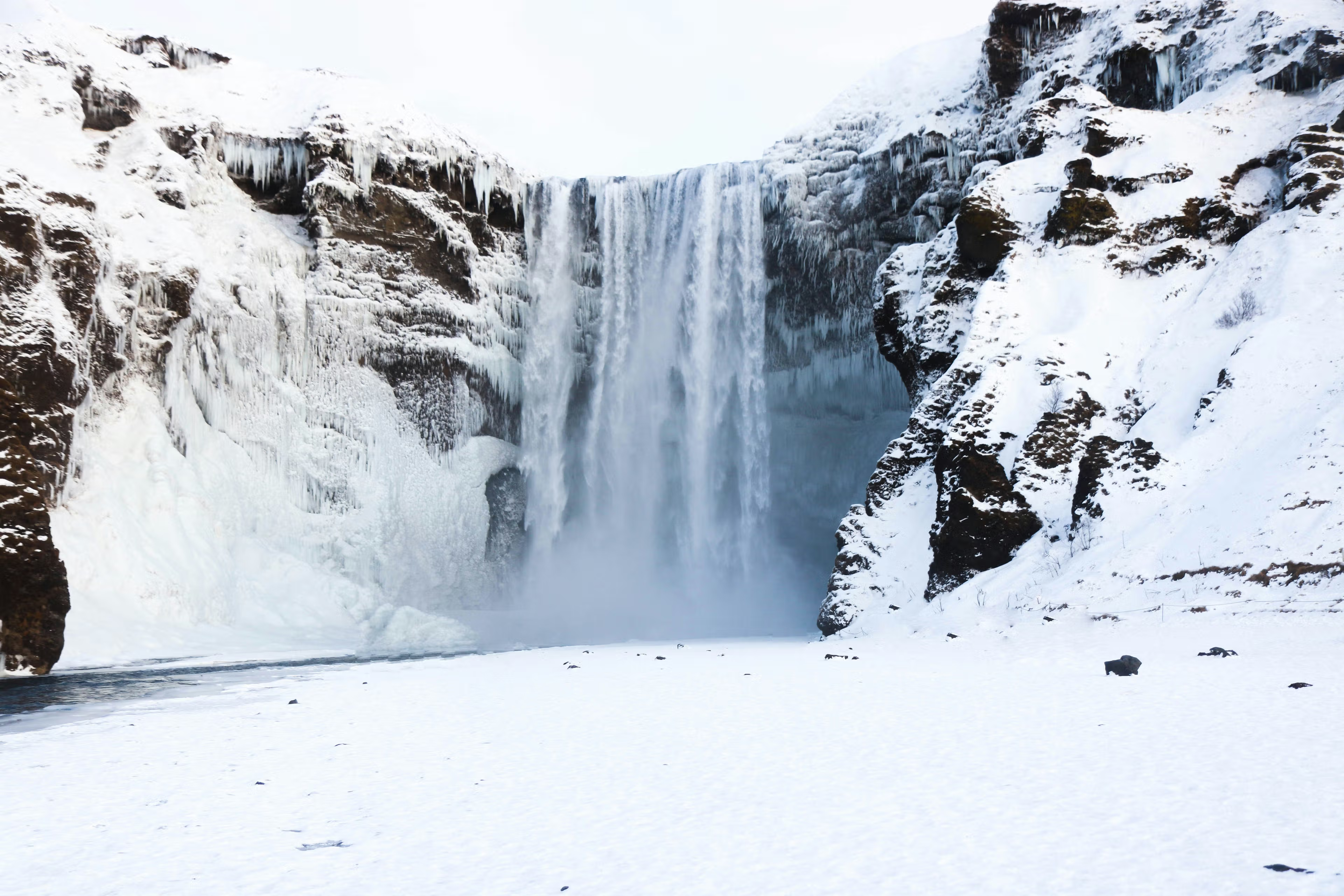
South Coast Wonders
This carbon-neutral Iceland South Coast tour is perfect for nature lovers looking to explore Iceland’s top natural attractions in just one day. Visit the stunning Seljalandsfoss and Skógafoss waterfalls, walk along the famous Reynisfjara black sand beach, see the breathtaking Sólheimajökull glacier, and experience the charm of Vík village—and enjoy incredible landscapes along the way.
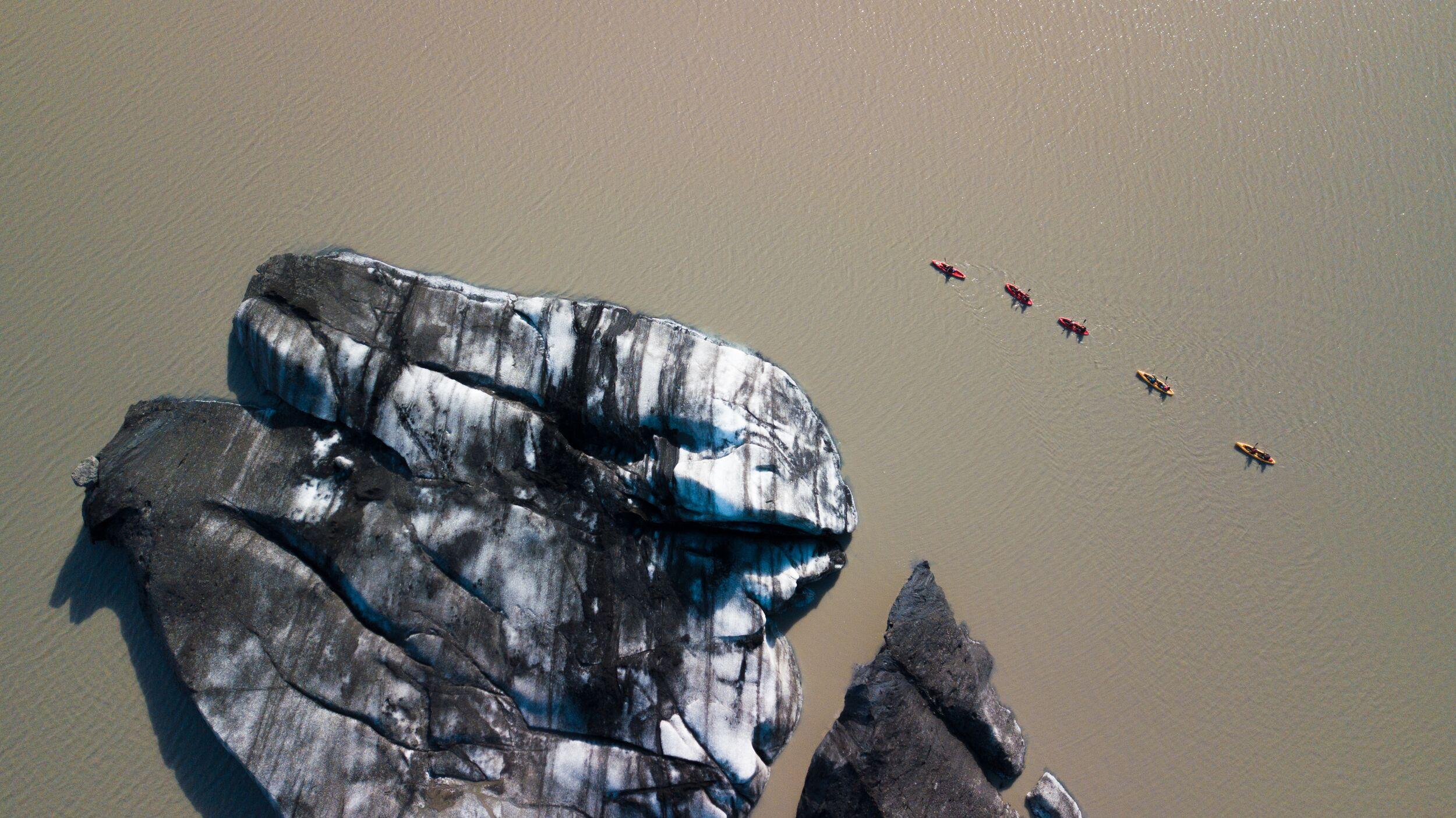
South Coast & Glacier Kayaking
Discover the essence of Iceland's natural beauty on this day tour, featuring two of Iceland's most renowned waterfalls and an exhilarating kayaking experience on a glacier lagoon. Journey through landscapes that blend cascading waters with icy wonders, all in a single, unforgettable day.
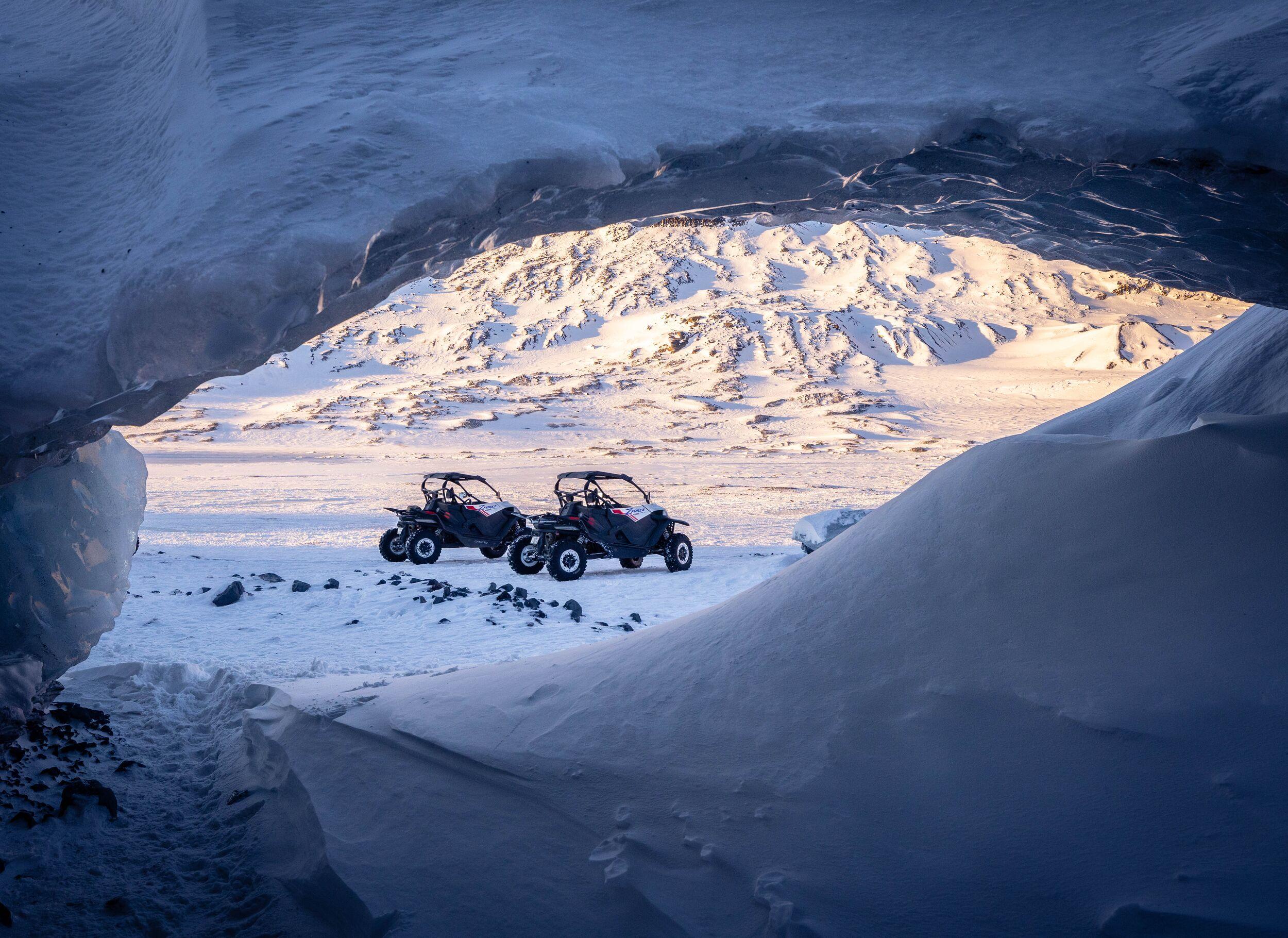
South Coast & Askur Ice Cave Adventure from Reykjavík
Explore Iceland's epic South Coast up close and personal. This tour features a thrilling ride to a newly discovered natural ice cave and Iceland's most iconic waterfalls Seljalands,foss and Skógafoss.
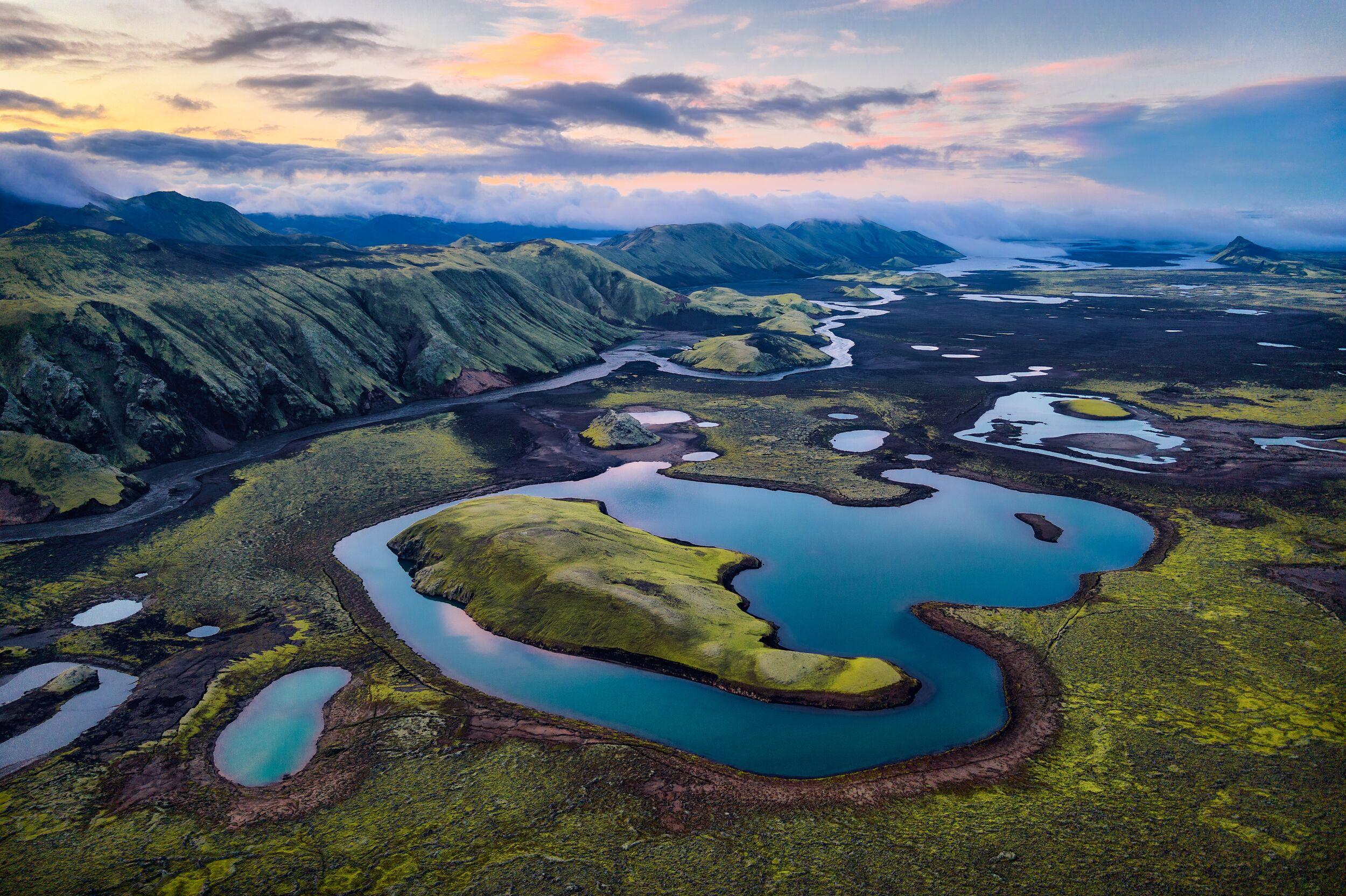
Iceland Highlands & South Coast Super Jeep tour
Iceland Highlands & South Coast Super Jeep Adventure Iconic sights. Hidden wilderness. One unforgettable ride.


